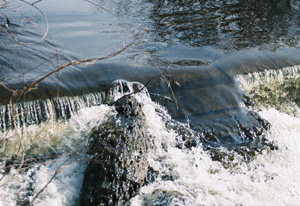
Her name -- Fredegond Shove -- is right out of Tolkein. An obscure Georgian poet, cousin of Virginia Woolf, she was, according to the CD liner notes, a friend of Ralph Vaughn Williams' first wife.
I'd been listening to Vaughn Williams' song "The Water Mill" for some time before I began to pay attention to the lyrics. (There's an excerpt at the link if you're curious.) It's a quiet, compelling little song, with the perpetuum mobile piano accompaniment obviously representing the non-stop turning of the mill wheel in the stream. The text is strangely detailed, a pleasant, rustic catalogue of aspects of the miller's life in pretty, conventional images such as "...swallows flit/ ...willows toss their silver heads..." short clauses often spilling over line breaks in a clever mimesis, again, of the turning wheel.
But there is, I soon realized, a dark undercurrent to this bucolic little song. The mill is "an ancient one,/Brown with rain and dark with sun." It is wizened and worn by the elements, brown, dark and ancient. Images of brightness and darkness alternate, like day and night, emblems, like the turning wheel, of the inexorable passage of time. The powerful, overwhelming passage, in fact --
"the waters roar/Out of the dark arch by the door."
It's hard not to hear death roaring out of that dark arch, darkness roaring into the sunlight.
In the miller's yard, the same drama plays out, death mentioned explicitly now.
"the phloxes in the garden beds/ turn red,turn gray with the time of day,/And smell sweet in the rain, then die away."
In a stanza about the mill loft, she writes
"The miller's cat is a tabby, she/Is as lean as a healthy cat can be."
implying that there are lean, unhealthy cats that prowl somewhere outside the poem. The beetles in the loft fare less well -- they "choke in the floury dust" -- a strangely awful, death-laden image, that leads to these two lines:
"The wheel goes round/and the miller's wife sleeps fast and sound."
Following the dust-choked beetles, this fast and sound sleep implies death, just as the lean but healthy cat implies illness and wasting. Next, the poet makes time explicit:
"There is a clock inside the house/Very tall and very bright/ It strikes the hour when shadows drowse/ Or showers make the windows white;"
I love this tall, bright clock and how tall brightness -- and artifice -- presides over the alternating darkness and light of passing time.
She mentions death explicitly a second time, in a stanza about the miller's children. They play "Barefoot, barehead, till the day is dead/and their mother calls them in to bed." The head/dead/bed rhyme seems to encircle the "children" in a complex image of the death/sleep to which their "mother" (who we previously encountered sleeping "fast and sound") summons them. This combination of end rhyme and internal rhyme adds to the poem's millwheel velocity. She employs this device several times -- gray-day-away in the passage about the phloxes, and the more occulted house-hour-drowse-shower in the clock stanza.
Finally, the tired miller eats at his "well scrubbed board" and drinks "like a thirsty lord," while streams of suitors come for his daughter --
"But she never knows which one to take: / She drives her needle and pins her stuff,/While the moon shines gold, and the lamps shines buff."
And on that odd note, it ends, with dangerously sharp pins and needles, "stuff" that seems more shroud than wedding dress, a distant golden moon, and intimate lamplight that's strange, muted, brown.
It is a song about ordinary life -- work, family, day, night, rain, sun -- and inexorable transience. The poem, like its clock, shines "tall and bright" over everything, taking its measure, also bound to fail.
No comments:
Post a Comment